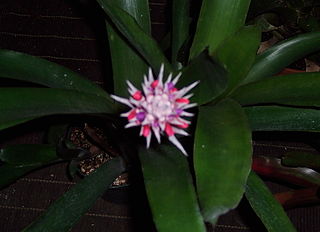
The Bromeliaceae is a family of monocot flowering plants of 75 genera and around 3590 known species native mainly to the tropical Americas, with several species found in the American subtropics and one in tropical west Africa, Pitcairnia feliciana.

Aechmea is a genus of flowering plants in the family Bromeliaceae. The name comes from the Greek aichme, meaning "spear". Aechmea comprises eight subgenera and around 250 species distributed from Mexico through South America and the Caribbean. Most of the species in this genus are epiphytes.

Aechmea bromeliifolia is a bromeliad native to southern Mexico, Central America, Trinidad, and South America as far south as northern Argentina.

Aechmea chantinii is a bromeliad native to the Amazon Rainforest vegetation in Brazil, Venezuela, Colombia, Ecuador and Peru. Commonly known as Amazonian zebra plant, it is often used as an ornamental plant.

Aechmea fulgens, the coralberry, is a bromeliad, which is often used like an ornamental plant. This plant grows in Brazil, especially in following states: Bahia and Pernambuco.

Aechmea fosteriana, the lacquered wine cup, is a bromeliad native to Brazil, which is endemic to coastal areas of the State of Espírito Santo. This plant is often grown as an ornamental plant.

Aechmea tillandsioides is a bromeliad widespread across southern Mexico, Central America, and northern South America. It is widely cultivated in other regions as an ornamental plant. This plant is cited in Flora Brasiliensis by Carl Friedrich Philipp von Martius.

Pothuava is a subgenus of the genus Aechmea.

Tillandsioideae is a subfamily of plants in the bromeliad family Bromeliaceae. This subfamily contains the greatest number of species (1,277). Most are epiphytic or lithophytic, growing in trees or on rocks where they absorb water and nutrients from the air. Spanish moss of the Tillandsia genus is a well-known variety. Bromeliads in the genera Guzmania and Vriesea are the more commonly cultivated members of this subfamily.

Aechmea dealbata is a bromeliad in the subfamily Bromelioideae. This plant species has spiny green foliage with a complex pink and purple inflorescence. It is epiphytic but will grow in soil and is commonly cultivated. This species is endemic to the State of Rio de Janeiro in Brazil.

Mulford Bateman Foster was a botanist known by many as the "Father of the Bromeliad" as he was instrumental in the discovery and introduction of many new species of Bromeliad to the United States. He also devoted his life to hybridizing and contributed widely to the knowledge of the plant species. He was a man of many talents including naturalist, explorer, writer, photographer, artist, horticulturist and a well-respected landscape architect in Florida. Numerous bromeliad plants found today are named after various Foster family members and the genus Fosterella is named in honor of his work.

Chevaliera is a subgenus of the genus Aechmea.

Macrochordion is a subgenus of the genus Aechmea.

Lamprococcus is a subgenus of the genus Aechmea.

Podaechmea is a subgenus of the genus Aechmea.

Ortgiesia is a subgenus of the genus Aechmea.

Aechmea zebrina is a plant species in the genus Aechmea. This species is native to Ecuador and Colombia; it is relatively common in the lowland Amazon region of eastern Ecuador and southern Colombia.
Aechmea haltonii is a bromeliad, a flowering plant in the genus Aechmea which is endemic to Panama.

Aechmea smithiorum is a plant species in the genus Aechmea. It is a medium-sized bromeliad with broad green leaves and a striking white rosette.

Aechmea subg. Aechmea is a subgenus of the genus Aechmea.




























